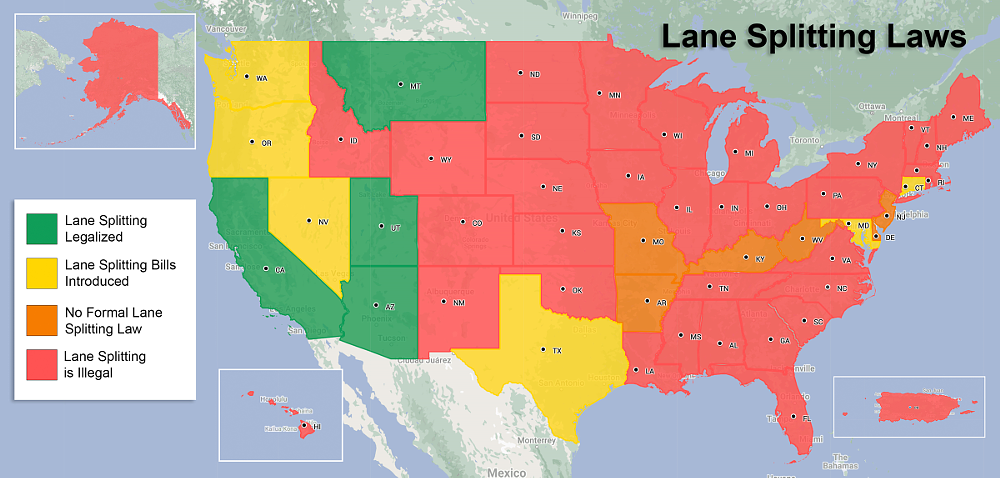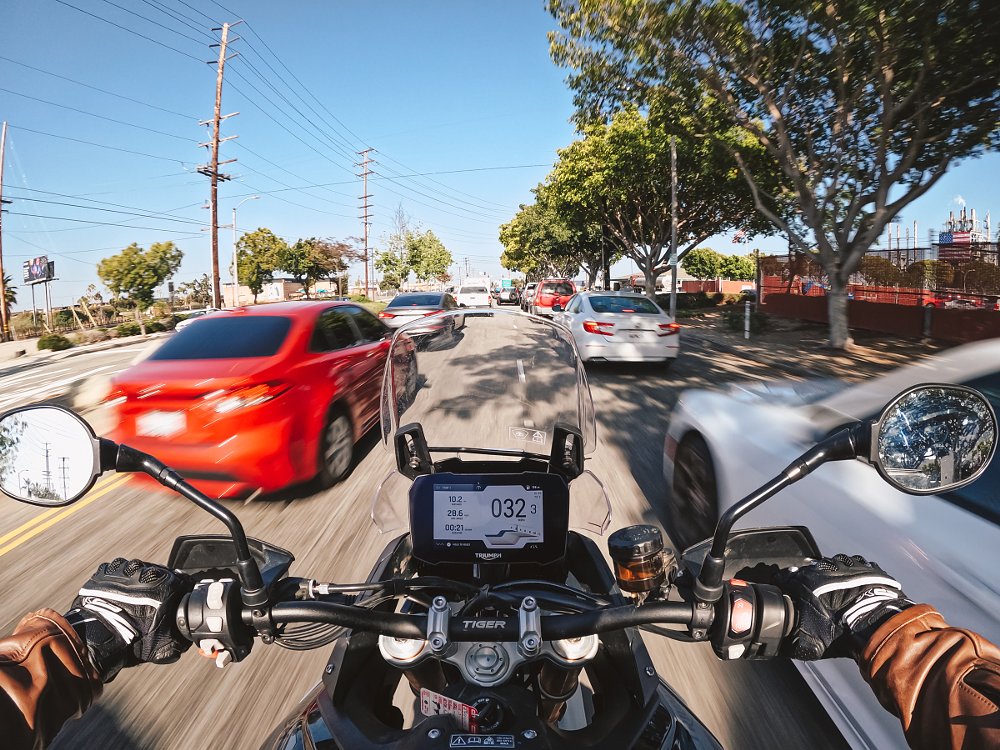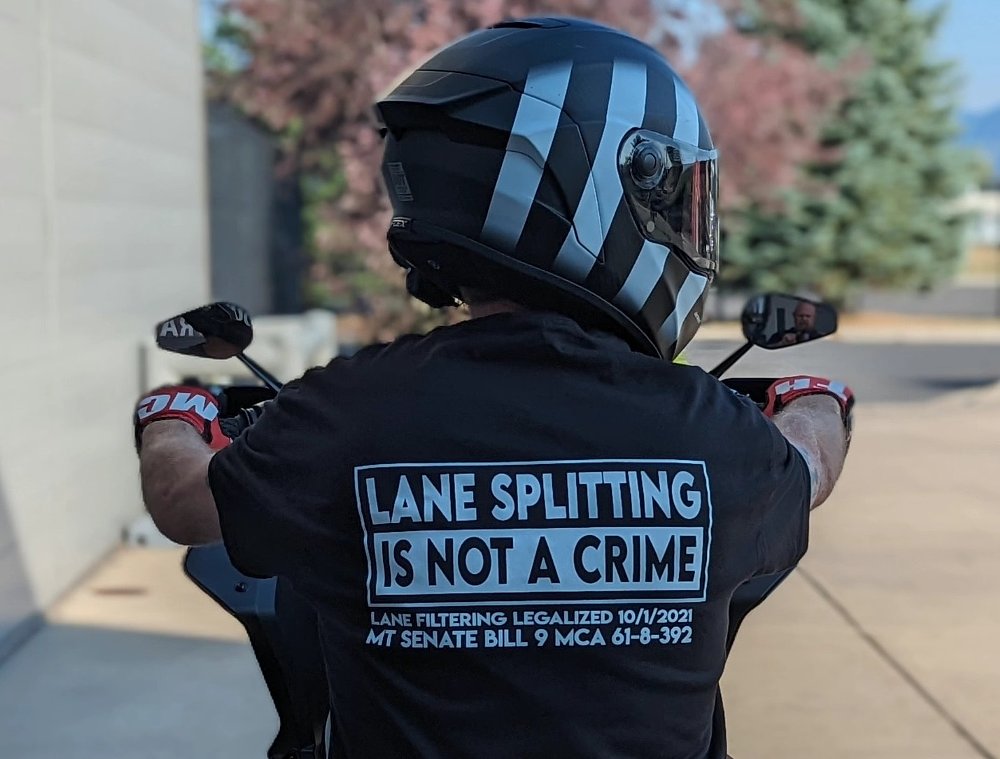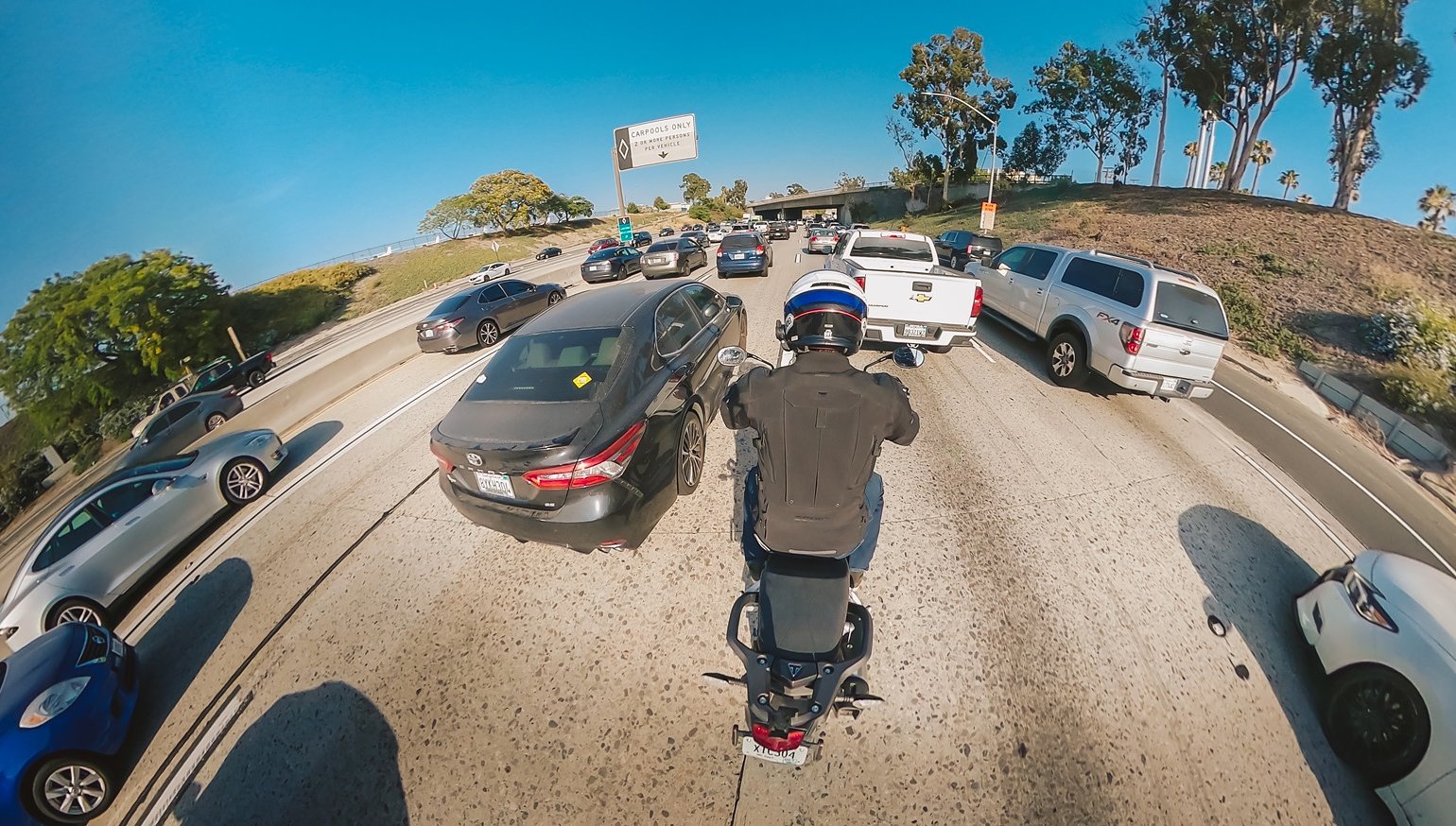I lived in London, England, when I took my motorcycle license test. Before starting the test ride, the examiner listed the (numerous) skills and knowledge he planned to assess, which included "demonstrating the ability to filter traffic safely and responsibly." In a weak attempt at a joke, I asked him what would happen if we didn't find any traffic. He glared at me for a long moment before saying, without a hint of irony, "I'll find you some."
I suspect a charisma bypass is part of their training. Of course, we would find traffic in gridlocked London. It was the main reason I'd bought a motorcycle; I was sick of sitting in it.
Traffic filtering or lane splitting, also known as white-lining or stripe-riding, is when a motorcyclist rides between lanes of slow or stopped traffic traveling in the same direction. In the UK, the practice has long been legal and is widely perceived as beneficial to traffic flow and rider safety. As such, demonstrating an understanding of how and when to split lanes safely is part of the general test.
I moved to New York and had ridden for months, lane splitting at every opportunity, when a State Trooper I'd just filtered past pulled me over. A nascent New Yorker can be forgiven for assuming the practice is legal in the Empire State. Motorcyclists invariably split lanes, which the cops tend to tolerate unless you ride dangerously or blatantly split past them. The trooper said I looked like Prince Charles, then let me off with a caution. I rode away wondering about the size of my ears but pleased I hadn't added any points to my newly minted driver's license.
My experience riding in Vermont was quite different. An incensed coroner, driving his personal minivan, flagged down our entire touring party for filtering past him in a line of traffic at a stop light, and called the police on us when we stopped to see what was wrong. Even the responding police officer he summoned, who issued all six of us tickets, appeared perplexed by his extreme reaction. I was "fresh off the boat" from Europe and astounded that something as innocuous as lane splitting could cause such consternation. And that a coroner could and would pull you over in his family car.
So definitely not legal in Vermont. Where can you lane split?

The status quo: Lane splitting is legal in four states
To date, only four states have legalized some form of lane splitting, although limitations vary in each state. Perhaps unsurprisingly, the state with the most motorcycles passed the first and broadest pro-lane-splitting law, which came into effect in 2017. Section 21658.1(a) of the California Vehicle Code defines the practice as "driving a motorcycle that has two wheels in contact with the ground, between rows of stopped or moving vehicles in the same lane, including on both divided and undivided streets, roads, or highways."
So, pulling wheelies while lane splitting in the Golden State is still prohibited. Additional guidelines provided by the California Motorcyclist Safety Program emphasize factors such as the width of lanes, the size of surrounding vehicles, prevailing weather conditions, and the heightened risks associated with greater speed differences between motorcycles and other vehicles.
In 2019, Montana enacted a law legalizing lane splitting, which it defined as "the act of overtaking and passing another vehicle that is stopped or traveling at a speed not in excess of 10 mph in the same direction of travel and in the same lane." The law also limits riders to 20 mph while splitting lanes.
Utah passed a more restrictive bill in 2017, which became the blueprint for Arizona’s 2022 law. Both states allow lane splitting at 15 mph or less through stopped traffic on roads posted with a maximum speed limit of 45 mph and with at least two lanes traveling in the same direction. Despite stipulating that traffic must be stationary, the wording inexplicably prohibits lane-splitting on Interstates and freeways.
New York and Vermont are two of the 40 states to have adopted legal statutes specifically prohibiting lane splitting. And it only gets more confusing with the remaining six states, which have no defining laws on the subject, leaving it to the arbitrary discretion of the police to determine what constitutes an infraction. It's safe to assume that lane splitting in these states could land you a ticket.
That covers the legalities of lane splitting, but what about the benefits?
Lane splitting (probably) improves rider safety
Lane splitting is a contentious issue in the United States, as seen in the reader comments every time Common Tread runs a story on the subject. Advocates argue that, done responsibly, it enhances rider safety, improves traffic flow, reduces emissions, and encourages more people to leave their cars at home. Critics say it is inherently dangerous and is unfair to drivers. What does the research show?

A lane-splitting study commissioned by UC Berkeley and the California Office for Traffic Safety collected state-wide data from motorists and motorcyclists over three years. In their follow-up report of 2015, Motorcycle Lane-splitting and Safety in California, T. Rice et al. concluded that riders who split lanes were significantly less likely to get rear-ended than riders who don't, and, in the event of an accident, were markedly less likely to suffer life-threatening injuries. The report also surmised that motorcycle speed and speed differential relative to the surrounding traffic were reliable indicators of lane-splitting accidents and the severity of any resulting injuries. Traveling at speeds above 40 mph correlated with a higher rate of accidents and injuries, and speed differentials over 15 mph caused exponentially more crashes.
Meanwhile, a French government-sanctioned study published in 2021 experimented with lane-splitting laws over four years in 11 of France's 96 administrative regions. French law does not permit or prohibit the maneuver, which is traditionally tolerated. The study implemented rules for splitting lanes safely and introduced driver and rider education practices. When taking increased traffic into account, the study proved inconclusive. However, accident rates increased by 12% within the experimental zones, predominantly among motorcyclists who failed to follow the new safety guidelines — quelle surprise! A French motorcyclist organization launched protests, saying the methodology of the study was flawed, but for now the experiment ended plans to make lane splitting officially legal, rather than just broadly tolerated, in France.
What about traffic flow and air quality?
A Belgian study published in 2011 used detailed computer modeling to research the effects of increasing the proportion of motorcycles in commuter traffic. The results suggest that lane splitting, coupled with an increase in motorcycle commuters, has the potential to significantly reduce commute times and greenhouse gas emissions. The study concluded that if just 10% of existing motorists traveled to work by motorcycle, all vehicles would spend 40% less time in traffic, and emissions would drop by 6%.
It's worth noting another study conducted by the Federation of European Motorcyclists' Associations (FEMA). It found that providing safe parking spaces and facilities for storing gear could result in a 30% increase in European bikers considering commuting by motorcycle. As with the Belgian research, the FEMA study's scenario presupposes that lane splitting is legal and widely practiced.
It's not easy to change attitudes
Regardless of evidence, changing laws and attitudes is challenging, as shown by so-far-unsuccessful efforts to legalize lane splitting in Connecticut, Maryland, Oregon, Texas, and Washington. Nevada passed a bill in 2019 legalizing the maneuver, subject to its Department of Transportation issuing new guidelines, which have yet to materialize. Motorcyclists make up less than 9% of all U.S. road users, and it is reasonable to assume that few lawmakers are also bikers, making motorcycle advocacy an uphill battle.
Nevertheless, due to the increased concerns over emissions and traffic density, more lawmakers are beginning to recognize the potential role motorcycles can play in reducing both. But, as the Belgian study suggests, only if lane splitting is legalized on all roads. So far, only California and Montana have endeavored to pass such laws, and another finding of the UC Berkeley study demonstrates why. Researchers found that 61% of California drivers disapproved of lane splitting, and less than 10% were strongly in favor. The overwhelming majority of drivers that disapproved cited safety concerns as their main reason, while just 3.8% said the practice is unfair.
Even after legalization, driver education is a common issue. Lane splitting has been legal in Montana for over two years, but an article in the Missoulian quotes Mike Schroeder, General Manager of Grizzly Harley-Davidson, who was spat at by a motorist as he split past. Schroeder started printing T-shirts that spelled out the law. He hopes that, if enough riders wear them, his shirts can play a role in educating drivers. Both the UC Berkeley and French studies also highlighted drivers' ignorance of the law as an issue affecting safety.

My take: Responsible lane splitting is good for all road users
Regardless of the laws where you live, if you commute by road or drive regularly, you know that motorcyclists split lanes. The practice may be legal, tolerated, or reviled, but it's happening anyway. Making lane splitting legal provides an opportunity to train and educate riders to do it safely. And, if Mike Schroeder's experience is anything to go by, policies should include provisions for educating motorists about changes in the law and to look out for motorcycles in stopped and slow-moving traffic.
London's diesel-slicked streets, inclement weather, and unrelenting traffic don't naturally lend themselves to riding, but it's still one of the most motorcycle-friendly cities I've ridden in. Traffic filtering has been legal for decades. Learning to do it safely is part of the test. Motorists have come to expect bikes between lanes and, I would argue, tend to be more aware, as a result. Leeds University conducted a survey of British motorcyclists in 2011. It asked respondents to provide the most important reason for purchasing a motorcycle. Among riders living in London, the most common answer was avoiding congestion. Riding for pleasure ranked fourth.
While the subject deserves more study and the supporting evidence is peppered with caveats, it still suggests that the rewards outweigh the risks, not just for motorcyclists, but for everyone in the traffic flow.








